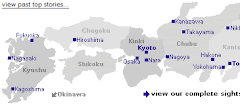
Japanese Events in January
"Akemashite omedetou gozaimasu (Happy New Year!)" In Japan the New Year begins with this greeting (Unlike English it can't be used before the New Year). The Japanese word for January is "ichi-gatsu (一月)" which literally means "the first month." In the old days it was called "mutsuki (睦月)." Click here to learn the old names of the months.
In Japan "shogatsu (New Year's holidays)" is a time when everybody takes a few days off to celebrate the arrival of the new year. It is often called "oshogatsu" with the prefix "o" to make it sound polite. Many people who are away from home, return to spend time with their family. Just like Christmas in West, the Japanese are looking forward to "oshogatsu." Here is the song titled "Oshogatsu."
Mou ikutsu neru to oshogatsu
Oshogatsu ni wa tako agete
Koma o mawashite asobimashou
Hayaku koi koi oshogatsu
もういくつ寝るとお正月
お正月には凧あげて
こまをまわして遊びましょう
早く来い来いお正月
Here are some events held in January.
1st Ganjitsu
元日 New Year's Day
2nd Kakizome
書初め First calligraphy of
the New Year
7th Nanakusa
七草 The seven herbs of spring
11th Kagami-biraki
鏡開き The cutting of the New Year's rice cake
Second Monday
(11th in 2010) Seijin no hi
成人の日 Coming-of-Age-Day
(National Holiday)

"Kakizome (書初め)" is the first calligraphy of the New Year. The subjects tend to be auspicious words or phrases. "Kakizome competitions (書初め大会)" are annual events at elementary and junior high schools.
"Nanakusa (七草)" literally means "seven herbs." It is customary to eat nanakusa-gayu (seven herb rice porridge) on January 7th. It is said that these herbs will prevent all kind of illnesses. Also, people tend to eat and drink too much on New Year's Day, therefore it is a ideal light and healthy meal with a lot of vitamins. Click here to learn more about "nanakusa."
The Seven Herbs of SpringOn January 7 families throughout Japan prepare kayu cooked with seven different vegetables, or haru no nanakusa (the seven herbs of spring). Kayu is a porridge made by cooking rice with twice the usual amount of water.
Kayu cooked with the seven herbs.
This practice came to Japan from China, where there was a custom of eating freshly harvested herbs early in the new year, but it's also been around in Japan for a long time, since there is a mention of it in Makura no soshi (The Pillow Book), written about a thousand years ago by a lady-in-waiting of the Japanese Empress. The seven herbs vary from region to region and also from era to era, but today they commonly consist of the leaves of dropwort, shepherd's purse, cottonweed, chickweed, henbit, turnip, and radish.
Eating these greens in the New Year was thought to replenish the body with energy from nature and to promote good health and longevity. It's a time-honored custom that's also very practical, since the herbs are a good remedy for indigestion from having had too much mochi (rice cakes) and other New Year's delicacies over the holidays.
"Kagami-mochi (鏡餅)" is a set of two round, flat rice cakes (one large, one small) stacked on a stand. It is displayed in the alcove and offered to the Shinto and Buddhist deities at the New Year. "Kagami-mochi" is taken down on "Kagami-biraki(鏡開き)" Day and eaten. Since it is taboo to cut it with a knife, it is cracked by hand or with a hammer.
"Seijin no hi (成人の日)" is a national holiday which honors young people who have turned, or who will turn, the age of 20 during the current year. At the age of 20, youths are officially recognized as adults and gain the right to vote as well as to drink and smoke. Most women wear traditional kimono to the ceremonies.





















 Kuala Lumpur Time
Kuala Lumpur Time















